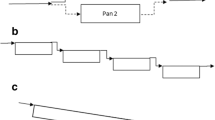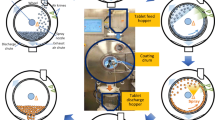Abstract
The relationships between coating uniformity and efficiency were explored for tablet coating processes in pan coaters. The factors affecting the size of the spray zone were modeled using one-dimensional deposition analysis of spray droplets. This model was incorporated into the analytical model developed for coating uniformity by Choi et al. (AAPS PharmSciTech 22(7), 2021) that farther elucidated the effects of tablet shape and bed porosity. The results were compared with literature data on coating efficiency. The variables examined included tablet shape and size, coating time, pan speed, atomizing and pattern air flow rates, bed porosity, spray rate, batch size, coating solution concentration, spray gun-to-bed distance, and pan diameter. It is shown that, except for pan diameter and atomizing air flow rate, variables that improve coating efficiency adversely affected coating uniformity and vice versa. Implications of these relationships are discussed to improve formulation, process, and equipment designs.











Similar content being viewed by others
References
Choi, M., Porter, SC., Macht, B., Meisen, A. Novel coating uniformity models for tablet pan coaters. AAPS PharmSciTech. 2021;22(7). https://doi.org/10.1208/s12249-020-01857-z
Porter SC, Bruno CH. Coating of pharmaceutical solid-dosage forms. Pharmaceutical dosage forms: Tablets. 1990;13:77–160.
Seo KS, Bajracharya R, Lee SH, Han HK. Pharmaceutical application of tablet film coating. Pharmaceutics. 2020;12(9):853. https://doi.org/10.3390/pharmaceutics12090853.
United States Pharmacopeial Convention: General Chapters: <905> Uniformity of Dosage Units, Pharmacopeial Forum. 2020;35(3):6673,7079,7183.
Choi M. Determining the manufacturability of drug-layered tablets. Pharmaceutical Manufacturing. 2007;6(4):34–42.
Tobiska S, Kleinebudde P. Coating uniformity and coating efficiency in a Bohle Lab-Coater using oval tablets. Eur J Pharm Biopharm. 2003;56(1):3–9.
Chen W, Chang SY, Kiang S, Marchut A, Lyngberg O, Wang J, et al. Modeling of pan coating processes: prediction of tablet content uniformity and determination of critical process parameters. J Pharm Sci. 2010;9(7):3213–25.
Brock D, Zeitler JA, Funke A, Knop K, Kleinebudde P. Evaluation of critical process parameters for intra-tablet coating uniformity using terahertz pulsed imaging. Eur J Pharm Biopharm. 2013;85(3):1122–9.
Boehling P, Toschkoff G, Knop K, Kleinebudde P, Just S, Funke A, Rehbaum H, Khinast JG. Analysis of large-scale tablet coating: modeling, simulation and experiments. Eur J Pharm Sci. 2016;90:14–24.
Kalbag A, Wassgren C. Inter-tablet coating variability: tablet residence time variability. Chem Eng Sci. 2009;64(11):2705–17.
Pandey P, Katakdaunde M, Turton R. Modeling weight variability in a pan coating process using Monte Carlo simulations. AAPS PharmSciTech. 2006;7(4):E2–11.
Tobiska S, Kleinebudde P. Coating uniformity: influence of atomizing air pressure. Pharm Dev Technol. 2003;8(1):39–46.
Chen W, Chang SY, Kiang S, Early W, Paruchuri S, Desai D. The measurement of spray quality for pan coating processes. J Pharm Innov. 2008;3:3–14.
Porter SC. Troubleshooting appearance-related problems of film coated tablets. Tablets and Capsules. 2008;6(3):16–22.
Ketterhagen WR, Larson J, Spence K, Baird J. Predictive approach to understand and eliminate tablet breakage during film coating. AAPS PharmSciTech. 2021;22:178. https://doi.org/10.1208/s12249-021-02061-3.
Wang J, Hemenway J, Chen W, Desai D, Early W, Paruchuri S, et al. An evaluation of process parameters to improve coating efficiency of an active tablet film-coating process. Int J Pharm. 2012;427(2):163–9.
Behie SW, Beekmans JM, Knetting P, Bulani W. Aerosol particle collection in a vertical pneumatic transport line. CJChE. 1972;50:241.
Choi M, Meisen A. Sulfur coating of urea in shallow spouted beds. Chem Eng Sci. 1997;52(7):1073–86.
Clift, R., Ghadiri, M., Thambimuthu, KV. Filtration of gases in fluidized beds, Progress and Filtration and Separation, v2 (ed Wakeman, R.J.) Elsevier, p75, 1981.
Lefebvre, AH. Atomization and Sprays, Taylor & Francis, p232, 1989.
Rege BD, Gawel J, Kou JH. Identification of critical process variables for coating actives onto tablets via statistically designed experiments. Int J Pharm. 2002;237(1–2):87–94.
Mundo, CHR., Sommerfeld, M., Tropea, C. Droplet-wall collisions: experimental studies of the deformation and breakup process. International Journal of Multiphase Flow. 1995;21(2):151–173.
Choi M. Applications of process thermodynamics in pharmaceutical coating. Tablets and Capsules. 2007;4:1–10.
Ebey GC. A thermodynamic model for aqueous film-coating. Pharm Technol. 1987;11(4):40–50.
am Ende, MT., Berchielli, A. A thermodynamic model for organic and aqueous tablet film coating, Pharmaceutical Development and Technology, 2005;10(1):47–58.
Mueller R, Kleinebudde P. Comparison of a laboratory and a production coating spray gun with respect to scale-up. AAPS PharmSciTech. 2007;8:E21–31.
Geldart, D. Single particles, fixed and quiescent beds, Gas Fluidization Technology (ed. Geldart, D.) John Wiley & Sons, p12, 1986.
Rowe RC. Predicting film thickness on film coated tablets. Int J Pharm. 1996;133(1–2):253–6.
Eastwood, J., Matzen, EJP., Young, MJ., Epstein, N. Random loose porosity of packed beds, Brit Chem Eng. 1969;14:1542–1545.
Weitz DA. Packing in the Spheres. Science. 2004;303(5660):968–9.
Author information
Authors and Affiliations
Contributions
All authors contributed to the study conception and design. Material preparation, data collection, and analysis were performed by Michael Choi, Stuart Porter, and Axel Meisen. The first draft of the manuscript was written by Michael Choi and all authors commented on subsequent versions of the manuscript. All authors read and approved the final manuscript.
Corresponding author
Ethics declarations
Conflict of Interest
The authors declare no competing interests.
Additional information
Publisher's Note
Springer Nature remains neutral with regard to jurisdictional claims in published maps and institutional affiliations.
Appendices
Appendix 1. Tablet diameter, surface area, and shape factor relationships
In deriving the mathematical relationships, tablet size is expressed in terms of its characteristic spherical diameter (i.e., the volume-equivalent diameter, dv), which is given by:
where vtab, wtab, and \(\rho\) tab denote the volume, weight, and density of the tablet. Note that the surface area of a sphere with this diameter (av) is given by
Substituting Eq. A1 and \({v}_{\mathrm{tab}}={w}_{\mathrm{tab}}/{\rho }_{\mathrm{tab}}\) into A2 gives
where wtab and \(\rho\) tab are the weight and density of a tablet, respectively. For non-spherical tablets, the surface area of the tablet (atab) is larger than av. Substituting this equation into Eq. 27 results in
Appendix 2. Shape factor, coating efficiency, and film thickness relationships
For small film volumes (vf) relative to the total tablet volume, the film thickness (lf) can be approximated by dividing the film volume by the tablet surface area:
vf is the weight of film on a tablet (wf) divided by the density of the film (\({\rho }_{f}\)): i.e.,
wf in the pan coating process is dependent on the amount of the coating applied to the tablet (wc) and the coating efficiency (ηc):
Note that wc is given by the total coating quantity divided by the number of tablets (= Wc/N) and the number of tablets is given by the feed weight of the uncoated tablets (Wu) divided by the uncoated tablet weight (wu).
Combining Eqs. 28, B1, B2, and B3 results in the relationship between wc, ηc, \({\rho }_{f}\), atab, and lf:
Rights and permissions
About this article
Cite this article
Choi, M., Porter, S.C. & Meisen, A. Interrelationships Between Coating Uniformity and Efficiency in Pan Coating Processes. AAPS PharmSciTech 22, 265 (2021). https://doi.org/10.1208/s12249-021-02155-y
Received:
Accepted:
Published:
DOI: https://doi.org/10.1208/s12249-021-02155-y




